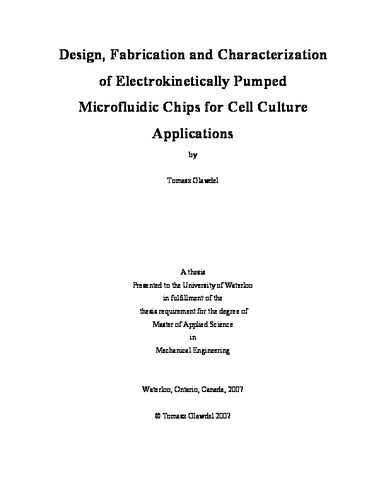| dc.contributor.author | Glawdel, Tomasz | |
| dc.date.accessioned | 2008-02-05 18:30:17 (GMT) | |
| dc.date.available | 2008-02-05 18:30:17 (GMT) | |
| dc.date.issued | 2008-02-05T18:30:17Z | |
| dc.date.submitted | 2007 | |
| dc.identifier.uri | http://hdl.handle.net/10012/3576 | |
| dc.description.abstract | Continuous perfusion cell culture chips offer the biomedical researcher unprecedented control over the microenvironment surrounding the cell which is not feasible with conventional static cell culture procedures. Applying microfluidics technology to these devices provides several benefits including increased fluid and media control, reduced consumption of reagents, continuous monitoring of cells and the potential for massively parallel experiments. In this work a new continuous perfusion cell culture chip is studied that utilizes electroosmotic pumping to control fluid flow. Problems associated with EOF and cells are solved by incorporating electroosmotic pumps (EO pumps) which generate an induced pressure driven flow in regions with cells. Several advantages of EO pumps include pulse free flow, quick flow control and precise movement of minute volumes of fluid. However, the high salt concentration in cell culture medium creates significant problems for EO pumps such as decreased flow rate due to low zeta potential, increased electrolysis due to large current draw, significant joule heating, bubble formation and polarization. Attempts to solve these problems with the proposed microfluidic chip are discussed.
The microfluidic chip is fabricated using soft lithography techniques developed as part of this work. The designs were modelled using a combination of numerical simulations with a commercial software program and compact circuit modelling. The pumps were integrated on-chip into a cell culture perfusion chip. The chip is adaptable due to the flexibility of the EO pumps to work as both pressure sources and virtual valves for regulating the fluid flow. Experiments with rainbow trout gill cells (RT-gill W1) were performed in order to validate the use of EO pumps for cell culture. Results show that the cells are not affected by the presence of the EO pumps as the electric field is isolated from the cells. However, the pumps were only able to operate continuously for eight hours before electrolysis effects stopped fluid flow. As a proof of concept, this shows that it is feasible to use EO pumps within a cell culture network. | en |
| dc.language.iso | en | en |
| dc.publisher | University of Waterloo | en |
| dc.subject | microfluidics | en |
| dc.subject | electrokinetic | en |
| dc.subject | cell culture | en |
| dc.title | Design, Fabrication and Characterization of Electrokinetically Pumped Microfluidic Chips for Cell Culture Applications | en |
| dc.type | Master Thesis | en |
| dc.pending | false | en |
| dc.subject.program | Mechanical Engineering | en |
| uws-etd.degree.department | Mechanical and Mechatronics Engineering | en |
| uws-etd.degree | Master of Applied Science | en |
| uws.typeOfResource | Moving Image | en |
| uws.typeOfResource | Text | en |
| uws.peerReviewStatus | Unreviewed | en |
| uws.scholarLevel | Graduate | en |

